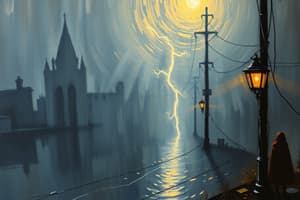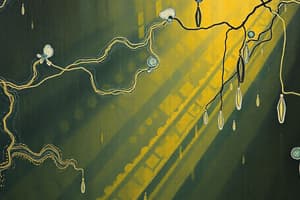Podcast
Questions and Answers
What is the unit of electric charge?
What is the unit of electric charge?
- Volt (V)
- Ohm (Ω)
- Ampere (A)
- Coulomb (C) (correct)
What does the equation $P = V imes I$ represent?
What does the equation $P = V imes I$ represent?
- Current is equal to power divided by voltage
- Energy is equal to power multiplied by voltage
- Power is equal to voltage multiplied by current (correct)
- Voltage is equal to power multiplied by current
Which of the following describes resistance?
Which of the following describes resistance?
- It is a measure of the energy supplied per charge
- It is the opposition to the flow of current (correct)
- It is the rate of flow of electric charge
- It is the voltage drop across a circuit element
How is energy calculated in an electrical circuit?
How is energy calculated in an electrical circuit?
What is the S.I Unit of capacitance?
What is the S.I Unit of capacitance?
What is the preferred value of a resistor?
What is the preferred value of a resistor?
What does an increase in current imply in a circuit with constant resistance?
What does an increase in current imply in a circuit with constant resistance?
What is the formula for calculating resistance in an electrical circuit?
What is the formula for calculating resistance in an electrical circuit?
What is the minimum resistance value of a resistor with a nominal value of $47k\Omega$ and a tolerance of $\pm 5%$?
What is the minimum resistance value of a resistor with a nominal value of $47k\Omega$ and a tolerance of $\pm 5%$?
In a 5-band resistor, what do the first three bands represent?
In a 5-band resistor, what do the first three bands represent?
What occurs when the voltage across a capacitor remains constant?
What occurs when the voltage across a capacitor remains constant?
What is the nominal resistance value for a resistor with the color bands: Brown, Black, Black, Brown, and Red?
What is the nominal resistance value for a resistor with the color bands: Brown, Black, Black, Brown, and Red?
What is the maximum resistance value of a $47k\Omega$ resistor with a tolerance of $\pm 5%$?
What is the maximum resistance value of a $47k\Omega$ resistor with a tolerance of $\pm 5%$?
How is the tolerance generally represented in a 5-band resistor?
How is the tolerance generally represented in a 5-band resistor?
What characteristic of a capacitor prevents voltage changes from happening instantaneously?
What characteristic of a capacitor prevents voltage changes from happening instantaneously?
Which band must be present as the last band in a 4-band resistor?
Which band must be present as the last band in a 4-band resistor?
What is the S.I. unit of inductance?
What is the S.I. unit of inductance?
Which statement about inductors is true?
Which statement about inductors is true?
What happens when the current through an inductor remains constant?
What happens when the current through an inductor remains constant?
Which of the following formulas represents inductance?
Which of the following formulas represents inductance?
Which term describes a material's ability to allow an electric field to establish?
Which term describes a material's ability to allow an electric field to establish?
What characterizes the magnetic field around a conductor carrying current?
What characterizes the magnetic field around a conductor carrying current?
In the equation $L = \frac{N^2 \mu A}{l}$, what does 'N' represent?
In the equation $L = \frac{N^2 \mu A}{l}$, what does 'N' represent?
Which of the following materials would likely have high permittivity?
Which of the following materials would likely have high permittivity?
What does the third color band in a 4-band resistor color code represent?
What does the third color band in a 4-band resistor color code represent?
What is the correct nominal resistance value for a resistor with color bands Brown, Black, Red, Gold?
What is the correct nominal resistance value for a resistor with color bands Brown, Black, Red, Gold?
Which of the following tolerance levels corresponds to a 5-band resistor color code?
Which of the following tolerance levels corresponds to a 5-band resistor color code?
If a resistor has color bands Yellow, Violet, Orange, and Gold, what is its nominal value?
If a resistor has color bands Yellow, Violet, Orange, and Gold, what is its nominal value?
What must be determined using the physical size of a resistor?
What must be determined using the physical size of a resistor?
What is the minimum resistance value for a resistor with a nominal value of 47 kΩ and a tolerance of ±5%?
What is the minimum resistance value for a resistor with a nominal value of 47 kΩ and a tolerance of ±5%?
In Powers of Ten Notation, how is the nominal value calculated from a resistor with the color bands 2, 1, 0, and 5?
In Powers of Ten Notation, how is the nominal value calculated from a resistor with the color bands 2, 1, 0, and 5?
When converting resistance from ohms to kilohms, which of the following is the correct conversion for 1,000 Ω?
When converting resistance from ohms to kilohms, which of the following is the correct conversion for 1,000 Ω?
Active devices can also be used as what?
Active devices can also be used as what?
What defines a series connection of elements?
What defines a series connection of elements?
In a parallel connection, what do the elements share?
In a parallel connection, what do the elements share?
What is the equivalent resistance of a series circuit with resistances of 5Ω, 10Ω, and 15Ω?
What is the equivalent resistance of a series circuit with resistances of 5Ω, 10Ω, and 15Ω?
If the total charge entering a terminal is given by $5 ext{sin}(4 ext{π}t) ext{mC}$, what is the current at $t = 0.5$ sec?
If the total charge entering a terminal is given by $5 ext{sin}(4 ext{π}t) ext{mC}$, what is the current at $t = 0.5$ sec?
Calculate the current ratings of a 100 Watt incandescent bulb and a 15 Watt LED lamp at 220 Volt.
Calculate the current ratings of a 100 Watt incandescent bulb and a 15 Watt LED lamp at 220 Volt.
What type of element is a battery classified as?
What type of element is a battery classified as?
If voltage increases linearly from 0 to 100 V in 0.1 s causing a current flow of 5 mA, what is the value of capacitance?
If voltage increases linearly from 0 to 100 V in 0.1 s causing a current flow of 5 mA, what is the value of capacitance?
Study Notes
Electrical Circuit
- An electrical circuit is a path that enables the flow of electrical current.
- It comprises interconnected components like resistors, capacitors, inductors, and sources like batteries.
- The movement of electrons through this path constitutes current.
Charge and Current
- Charge (Q) is a fundamental property of matter related to an object's ability to produce electrical forces.
- It is measured in Coulombs (C).
- Current (I) is the rate of flow of charge over time.
- It is measured in Amperes (A), where 1 Ampere represents the flow of 1 Coulomb per second.
- Mathematically, current (I) is the derivative of charge (Q) with respect to time (t).
- The formula is: I = dQ/dt
Voltage
- Voltage (V) represents the electrical potential difference between two points in a circuit.
- It is the amount of energy required to move a unit charge between these points.
- Measured in Volts (V).
Power and Energy
- Power (P) is the rate at which work is done or energy is transferred.
- Measured in Watts (W).
- Formula: P = dW/dt = V * I
- Energy (E) is the capacity to do work.
- Measured in Joules (J).
- Formula: E = P * t = V * I * t
Network Components
- Active components are devices that supply energy to a circuit, such as batteries and generators.
- Passive components are devices that consume or store energy, such as resistors, capacitors, and inductors.
Resistance
- Resistance (R) is the opposition to the flow of electrical current.
- It is measured in Ohms (Ω).
- Formula: R = V/I
- Resistor Color Code:
- Four-band resistors: The first two bands represent the significant digits, the third band is the multiplier, and the fourth band indicates tolerance.
- Example: Brown (1) Black (0) Red (2) Gold (5%) indicates a 100 Ohm resistor with 5% tolerance.
- Five-band resistors: The first three bands represent the significant digits, the fourth band is the multiplier, and the fifth band indicates tolerance.
- Example: Brown (1) Black (0) Black (0) Brown (1) Red (2%) indicates a 100 Ohm resistor with 2% tolerance.
- Four-band resistors: The first two bands represent the significant digits, the third band is the multiplier, and the fourth band indicates tolerance.
Capacitance
- Capacitance (C) is a component’s ability to store electrical energy in an electrostatic field.
- It is measured in Farads (F).
- Formula: Q = CV (where Q is the charge and V is the voltage)
- Two important properties:
- No current flows through a capacitor if the voltage remains constant.
- The voltage across a capacitor cannot change instantaneously.
Inductance
- Inductance (L) is the property of an electrical conductor that opposes changes in current flow.
- It is measured in Henrys (H).
- Formula: V = L * dI/dt (where V is the voltage and I is the current)
- Two important properties:
- No voltage appears across an inductor if the current remains constant.
- The current through an inductor cannot change instantaneously.
Series Connection
- Series connection means elements are connected in a continuous path, sharing a single node.
- All elements in series share the same current.
Parallel Connection
- Parallel connection means elements are connected across the same two nodes, and consequently have the same voltage across them.
Equivalent Resistance
- Series: In a series connection, the equivalent resistance (Req) is the sum of individual resistances
- Parallel: In a parallel connection, the reciprocal of the equivalent resistance is the sum of the reciprocals of individual resistances.
Important Considerations
- Active devices can operate as amplifiers, choppers, converters, and inverters.
- LEDs have a significantly lower current consumption compared to incandescent bulbs at the same power rating.
- Capacitance is related to the permittivity of the material between the capacitor plates.
Studying That Suits You
Use AI to generate personalized quizzes and flashcards to suit your learning preferences.
Related Documents
Description
Explore the fundamental concepts of electrical circuits, charge, current, voltage, and power. Understand how these elements interact to facilitate the flow of electricity. This quiz will test your knowledge on the core principles that govern electrical engineering.




